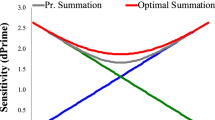Abstract
Ten electrocutaneous codes suitable for sensory feedback were systematically compared using a random tracking task. The representative sample of codes used single and multiple electrode displays, bipolar and monopolar electrocutaneous stimuli, and frequency, intensity, and spatial modulation. The experimental results from 2 preliminary studies using 4 subjects each, and a full scale study, using 21 subjects, suggested that electrocutaneous tracking was a reliable and sensitive indicator of a code's intrinsic effectiveness for transmitting information cutaneously. In addition, multiple electrode codes using spatial modulation were clearly and significantly superior to any single electrode codes examined. Single electrode codes using frequency modulation were superior to intensity modulation codes whether the pulse stimulus used was monopolar or bipolar. Although subjects rated bipolar stimulation as being slightly more comfortable than monopolar stimulation, they performed better when using monopolar stimulation. Furthermore, sensory adaptation to the monopolar stimulus was considerably less than to the bipolar stimulus. The most effective multiple electrode code was Seven Electrodes in a Linear Array on the Abdomen. The most effective single electrode code was the Low Pulse Rate Modulation Code, wherein the sensory information was embedded in pulse rates between 1 and 15 per second.
Similar content being viewed by others
References
Bach-y-Rita, P., and Collins, C. C. Sensory substitution and limb prosthesis. InAdvances on external control of human extremities. Belgrade, Yugoslavia, 1970. Pp. 9–21.
Beeker, T. W., During, J., and den Hertog, A. Artificial touch in a hand prosthesis.Medical and Biological Engineering 1967,5, 47–49.
Childress, D. S. Powered limb prostheses: Their clinical significance.IEEE Transactions on Biomedical Engineering May 1973,BME-20, 200–207.
Cochran, W. G., and Cox, G. M.Experimental designs. London: Wiley, 1950. Pp. 259–273 and 315–345.
Collins, C. C., and Madey, J. Tactile sensory replacement. InProceedings of the San Diego biomedical symposium, San Diego, California, February 6–8, 1974. Vol. 13, pp. 15–26.
Cox, D. R.Planning of experiments. New York, Wiley, 1958, Pp. 191–246.
Gescheider, G. A. Some comparisons between touch and hearing.IEEE Transactions on Man-Machine Systems March 1970,MMS-11, 28–35.
Kato, I., Kumamoto, M., Tamura, S., and Tsunekawa, Y. Human cognitional ability for electrical stimulation signals. InAdvances in external control of human extremities, Belgrade, Yugoslavia, 1970a. Pp. 68–84.
Kato, I., Yamakawa, S., Ichikawa, K., and Sano, M. Multifunctional myoelectric hand prosthesis with pressure sensory feedback system.Proceedings of the fourth international symposium on external control, Dubrovnik, Yugoslavia, August, 1970b.
Prior, R. E., and Lyman, J. Electrocutaneous sensory feedback for artificial limbs: Single electrode encoding of grasp force and hand position from an externally energized hand. InProceedings of the fifth international symposium on external control of human extremities, Dubrovnik, Yugoslavia, August, 1975.
Prior, R. E., Case, P. A., and Lyman, J. Hook opening feedback for the below elbow amputee. InProceedings of the San Diego biomedical symposium, San Diego, California, February 2–4, 1977. Vol. 16, pp. 357–368.
Saunders, F. A. Electrocutaneous displays. In Geldard (Ed.),Conference on vibrotactile communication. Austin, Texas: The Psychonomic Society, 1974.
Solomonow, M., Freedy, A., and Lyman, J. Frequency modulated cutaneous orientation feedback from artificial limbs. InProceedings of the 11th annual conference on manual control. NASA-Ames; Moffett Field, California, 1975.
Szeto, A. Y., Prior, R. E., Duncan, J. S., and Lyman, J. Comparison of electrocutaneous codes for sensory feedback.Proceedings of the San Diego biomedical symposium, San Diego, California, February 4–6, 1976a. Vol. 15, pp. 109–114.
Szeto, A. Y., Prior, R. E., and Lyman, J. Evaluation of electrotactile codes. InProceedings of the 29th annual conference of engineering in medicine and biology, Boston, Massachusetts, November 6–10, 1976b. Vol. 18, p. 120.
Szeto, A. Y.Electrocutaneous codes for sensory feedback in prostheses and orthoses. Ph.D. Dissertation, Univ. of California, Los Angeles, California, March 1977.
Author information
Authors and Affiliations
Additional information
This research was supported by the National Institute of Health through Grant GM 21430-03.
Rights and permissions
About this article
Cite this article
Szeto, A.Y.J., Lyman, J. Comparison of codes for sensory feedback using electrocutaneous tracking. Ann Biomed Eng 5, 367–383 (1977). https://doi.org/10.1007/BF02367316
Received:
Issue Date:
DOI: https://doi.org/10.1007/BF02367316




